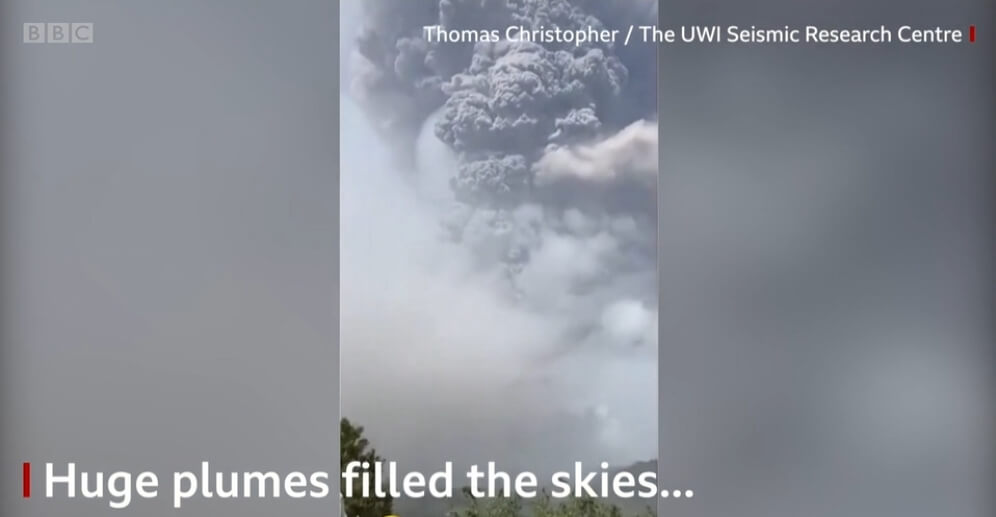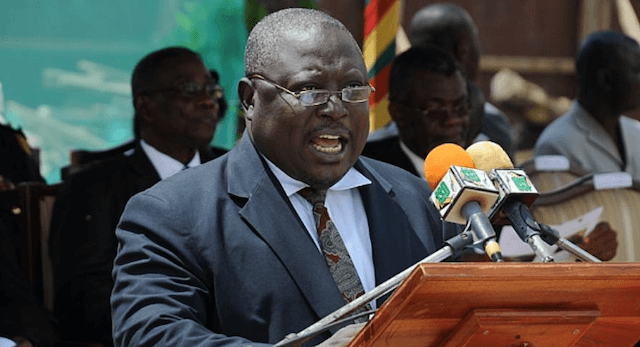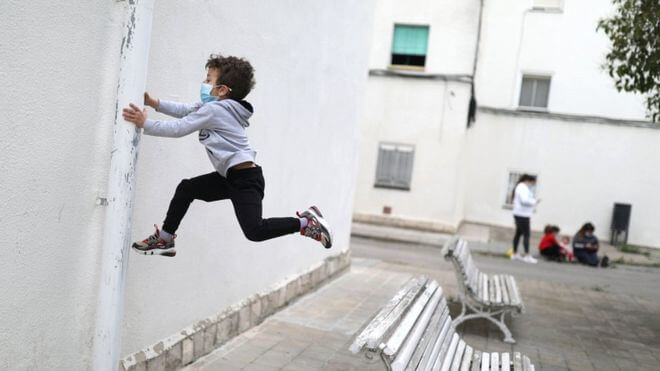St Vincent volcano: Eruptions likely in coming days, experts warn

The Caribbean island of St Vincent is likely to see further volcanic eruptions and ash fall over the coming days, experts have warned.
The La Soufrière volcano first erupted on Friday, blanketing the island in a layer of ash and forcing more than 16,000 people to evacuate their homes.
Smaller explosions continued over the weekend, triggering widespread outages of electricity and water supplies.
Emergency officials have described the landscape as a “battle zone”.

“The volcano continues to erupt explosively with the production of copious amounts of ash,” the University of the West Indies’ Seismic Research Center said.
“Explosions and accompanying ash fall, of similar or larger magnitude, are likely to continue to occur over the next few days impacting St Vincent and neighbouring islands,” it warned.
June Shipley, who is visiting her family on the island, told the BBC there were widespread fears a larger eruption could be imminent.
“We do hear the rumblings of the volcano and we do see the smoke,” she said.

White-coloured dust has covered buildings and roads around the island, including in its capital Kingstown.
The warning to expect further activity at La Soufrière followed what officials described as an “explosive event” on Sunday.
The emergency management organisation Nemo tweeted: “Massive power outage following another explosive event at La Soufriere Volcano. Lightning, thunder and rumblings.”
It later spoke of “possible destruction and devastation of communities close to the volcano”, and compared the eruption to that of 1902, the worst in St Vincent’s history when more than 1,000 people were killed.
Rhiannon West, who is originally from England, lives in the south-east of St Vincent with her partner and six-month-old baby. She told the BBC about her experience:
We stood outside our home on Saturday and watched as the volcano erupted and a huge billowing cloud of ash was sent into the air. It was incredible but also terrifying.
Since then we’ve been sheltering indoors with everything closed.
It’s scary thinking about what we can do to protect the baby from the ash. We’ve put sheets around the bottom of the doors to make sure none of it gets in.
We keep losing electricity, and we’ve had no running water since Thursday. Our local shop has run out of bottled water, and it’s very scary to think we could run out ourselves.
This could go on for weeks and neither of us can work because of the power supply issues.
The atmosphere is just very eerie. Everything is grey with a thick layer of ash and people are scared that these eruptions could get worse.

How are residents coping?
More people fled their homes on Sunday amid fears of further volcanic activity and ash fall.
More than 3,000 people have been staying at government-run shelters around the island. Cruise ships have also been readied to take evacuees to nearby islands.
St Lucia, Antigua and Grenada have all offered to open their borders to evacuees. A group of 130 people have already been taken to St Lucia.
Meanwhile, Nemo urged those remaining on the island to “be careful on the roads, which have become treacherous as a result of the ash flow”.
Ash has hardened on the ground after rain showers and many homes are without water and electricity, emergency officials said early on Sunday.
Some residents said power had been restored later in the day, but several areas are still in the dark.
Prime Minister Ralph Gonsalves said water supplies to most of the island had been cut off and its airspace closed because of the smoke and thick plumes of volcanic ash moving through the atmosphere.
He earlier said that a lot of volcanic ash had fallen over the sea. “We don’t know how much more is going to come out… so far, we have done well in that nobody got injured, nobody is dead.”
The Barbados Defence Force has been deployed to provide humanitarian assistance, the Caribbean Disaster Emergency Management Agency said.
How is the wider region being affected?
The ash has also spread beyond St Vincent, reaching as far as Barbados which is 120 miles (190 km) to the east. People there have been urged to stay indoors and told to avoid breathing in the ash.
“This is to protect yourselves and your family,” said Chief Medical Officer Kenneth George.
People on the island of St Lucia, which is around 47 miles north of St Vincent, have been warned to expect air quality to be affected, with harmful gases potentially making it harder to breathe for people with conditions such as asthma.

One resident of St Lucia, Olivia, told the BBC that she was worried about a possible change in wind direction and ash being carried northwards.
“I am terrified of all the effects that are unknown at this point, ash in the middle of a pandemic – no-one is prepared for that,” she said.
“Victoria Hospital has been transformed to become the Respiratory Hospital, and is treating Covid patients” she said, adding: “So technically, persons suffering from the effects of ash inhalation would be on the wards with Covid patients.”
When did the new eruptions begin?
The volcano had been dormant since 1979, but in late 2020 it started spewing steam and smoke and making rumbling noises.
The first sign that an eruption was imminent came on Thursday evening, when a lava dome became visible on La Soufrière.
Just before 09:00 on Friday (13:00 GMT), seismologists from the University of the West Indies confirmed that an “explosive eruption” was under way.
Source: BBC NEWS
Oral Ofori is Founder and Publisher at www.TheAfricanDream.net, a digital storyteller and producer, and also an information and research consultant.




